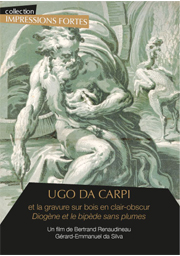-

Chiaroscuro wood engraving
Ugo da Carpi
-

-

-

-

-

-

-

-

-

-

IMPRESSIONS FORTES
Chiaroscuro wood engraving
Technique・ Woog engraving
Length・ 40 minutes, HD
Language・ Français
Subtitles・ English
Date of production・ 2018
Direction・ Bertrand Renaudineau et Gérard-Emmanuel da Silva

In 16th century Italy, Ugo da Panico, known as Ugo da Carpi (the name of his hometown), engraved this magnificent Diogenes after Parmigianino’s drawing. It illustrates the cynical philosopher’s ironic response to Plato, who had defined man as a “featherless biped”... The four superimposed plates, each in a different tone of green, produces a chiaroscuro effect and marked the beginning of color wood engraving.
The film retraces the first stages of a process begun a few decades earlier in Germany with, among others, Baldung Grien and Cranach.
Five centuries later, in his Vincennes workshop, José San Martin, painter, draftsman and engraver, skillfully uses strongly asserted colors to create a print using five superimposed plates.



